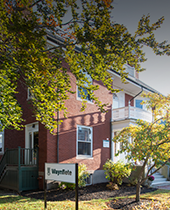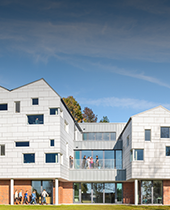In Franklin Theater on the evening of April 8, Waynflete will host the fifth annual State of the Ocean Series Talk. Having taught Marine Biology for more than twenty years, I have developed a deep passion for the ocean and the organisms that live within it. I have grown keenly interested in how people respond to the question, Why does the ocean matter? So I asked a variety of students this question, and here are some samples of what they said:
• “The organisms in the ocean can give us new insights on medical and behavioral research.”
• “If there were no ocean, the human race would not exist”.
• “It helps control the earth’s temperature.”
• “The ocean provides protein for 1 in 5 people on the earth, and personally, I love outdoor activities on the water”.
• “It provides food, jobs, and helps to maintain a stable environment.”
• “There are so many discoveries that still need to be made in the ocean. To me it is our most valuable resource and the true final frontier.”
• “The ocean matters because it sustains life and has been a crucial part of evolution”.
• “In a practical sense, it provides food and a home for most life on earth. In a more abstract sense, it symbolizes the vastness and wonder of life and the endless possibility of evolution.”
• “Without the ocean there would be no evaporation which would mean no precipitation”.
• “It is home to a huge portion of earth’s life that is essential to earth’s ecosystem”.
• “It is the basis of all life, and it affects all of us.”
• “We have to take good care of the ocean for our health and safety as well as the earth’s”.

Photo by Brian Skerry
These statements express much insight and understanding. Given that 70% of the earth’s surface is covered with ocean, that every second breath you take comes from oxygen produced by phytoplankton in the ocean, that the ice caps are melting, coral reefs are dying, the ocean is acidifying, and that most of the big fish are gone from the ocean, asking why the ocean matters again and again is increasingly important. As a school, we are committed to responsible environmental citizenship, and one of the ways we do this is to host the State of the Ocean Speaker Series. In each of the past four years, together with a wide variety of ocean-focused organizations, we have brought in a speaker who has dedicated his life to the ocean by capturing remarkable images in still photos, exploring its deepest places by remote-operated submarine, capturing the last 5% of truly pristine areas on video, or raising public awareness about the ocean-related challenges that each country in the world currently faces. Brian Skerry, David Gallo, Feo Pitcairn, and Steve Katona each brought compelling messages to their audiences about why the ocean matters. Their collective message boils down to this: No matter where you live, your life depends on the ocean. Furthermore, we are on a path that could result in irreversible consequences to the health of this vital aspect of our earth.
For many of us, when we look out at the ocean from the shoreline, we see how large it is and know it is remarkably deep. Most of us understand that on some level we generate a lot of waste that ends up in the ocean. Yet, our ability to see beneath the ocean surface and to truly understand the impact that humans have on it is significantly limited. In the right frame of mind, however, we can learn valuable lessons about our throw-away tendencies. For example, on the macroscopic level, of the top 10 types of trash found in beach cleanups monitored by the Center for Conservation since 1986, 7 were plastics of some type. (http://www.takepart.com/oceans/plastic-pollution).
 By itself this statistic is alarming, but add to it the following pieces of information: The average American will throw away approximately 185 pounds of plastic and use more than 1,200 plastic bags in a year. Plastic in the ocean breaks down into such small segments that pieces of plastic from a one liter bottle could end up on every mile of beach throughout the world. And plastic is durable, it takes about 1000 years to degrade completely (http://www.takepart.com/oceans/plastic-pollution). Sea Education Association (SEA) scientists studied plastics in the Atlantic and calculated there are 580,000 pieces of plastic per square kilometer. Many of the plastics are slowly breaking down in the ocean and releasing their own toxins, such as BHA, which is used as an antioxidant in many plastics. If you are interested, you can read more about this by clicking here.
By itself this statistic is alarming, but add to it the following pieces of information: The average American will throw away approximately 185 pounds of plastic and use more than 1,200 plastic bags in a year. Plastic in the ocean breaks down into such small segments that pieces of plastic from a one liter bottle could end up on every mile of beach throughout the world. And plastic is durable, it takes about 1000 years to degrade completely (http://www.takepart.com/oceans/plastic-pollution). Sea Education Association (SEA) scientists studied plastics in the Atlantic and calculated there are 580,000 pieces of plastic per square kilometer. Many of the plastics are slowly breaking down in the ocean and releasing their own toxins, such as BHA, which is used as an antioxidant in many plastics. If you are interested, you can read more about this by clicking here.

Photo Credit: true2death, CCN, Local Philosophy; Published November 15, 2012
There has been a lot of press in the last few years about the Great Pacific Garbage Patch, located at the confluence of several major currents in the Pacific. One scientist who has helped to publicize it with the scientific community and the general public is oceanographer and chemist Charles Moore, now with the Algalita Marine Research Foundation. “Plastic hits marine creatures with a double whammy,” Moore said in an interview with National Geographic. “Along with the toxic chemicals released from the breakdown of plastic, animals also take in other chemicals that the plastic has accumulated from outside sources in the water. We knew ten years ago that plastic could be a million times more toxic than the seawater itself, because plastic items tend to accumulate a surface layer of chemicals from seawater. They’re sponges.” Most of us also probably know that many marine organisms inadvertently ingest plastics while feeding or mistake plastics for their food source. In either case, marine organisms that ingest plastics are not only taking in the plastics but also all of the chemicals that have latched on to the surface of the plastics.
So, for all of the reasons that the ocean matters, it is crucial that we understand the impact of plastics pollution in the ocean. To this end, the Gulf of Maine Marine Education Association (GOMMEA) has organized an event to be held at Waynflete entitled “Plastics at SEA” featuring oceanographer and Sea Education Association research scientist Dr. Kara Lavender Law. SEA students and scientists began collecting data on floating plastic debris in the 1980s. Dr. Lavender Law will review the state of scientific research on marine debris in the world’s oceans and share her in-depth look at research carried out for more than 25 years by undergraduate students and faculty scientists on sailing oceanographic research vessels at SEA.

http://blog.oceanconservancy.org/tag/why-the-ocean-matters/
It is my sincere hope that you will take a moment to answer the question for yourself: “Why does the ocean matter”? Then, I hope that you demonstrate your understanding of why the ocean matters by joining us at “Plastics at SEA” on Tuesday, April 8th. For details on the event, click here.





 At the event, we were introduced to the sponsors, question masters, judges, referees, and our competitors from high schools across the state. The woman who ran the competition told the group that we would first be competing in a Mock Round. My nerves instantly set in. I am not the kind of person who enjoys public speaking, never mind having the spotlight on me to answer questions. And just my luck. Waynflete was called up first, and I had the brains to pick the first seat by accident. They explained that we would be competing in a buzzer round, where the first person to buzz in gets to answer. She started reading. “What three digit number do you call for emergencies?” I thought to myself, “If this is what the competition is like, then I am in for the easiest day of my life.”
At the event, we were introduced to the sponsors, question masters, judges, referees, and our competitors from high schools across the state. The woman who ran the competition told the group that we would first be competing in a Mock Round. My nerves instantly set in. I am not the kind of person who enjoys public speaking, never mind having the spotlight on me to answer questions. And just my luck. Waynflete was called up first, and I had the brains to pick the first seat by accident. They explained that we would be competing in a buzzer round, where the first person to buzz in gets to answer. She started reading. “What three digit number do you call for emergencies?” I thought to myself, “If this is what the competition is like, then I am in for the easiest day of my life.”



